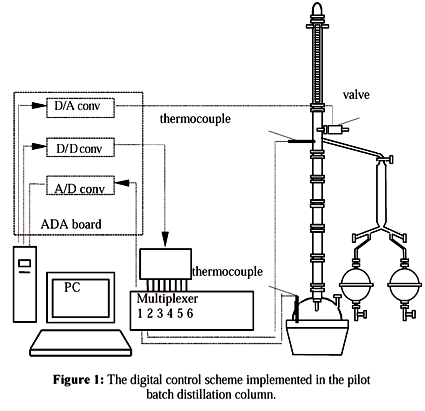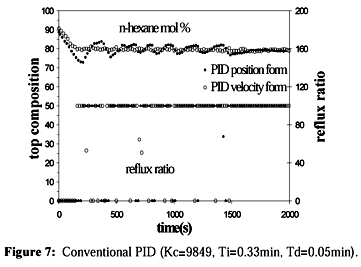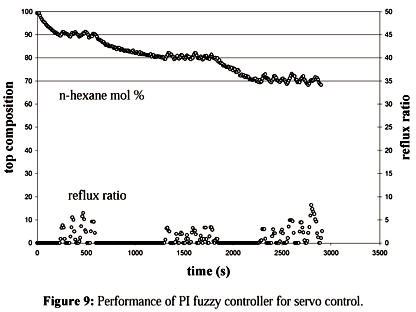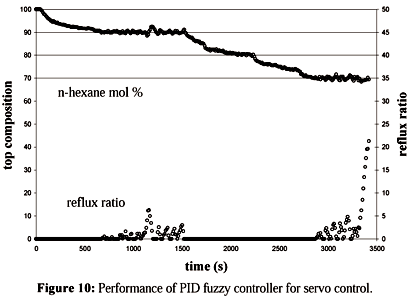Abstract
The present work describes the development and implementation of fuzzy control algorithms in order to control on-line the overhead product composition of a batch distillation column. Firstly, the influence of design parameters was evaluated through computational simulations and then the algorithms were experimentally tested by monitoring a pilot column. Binary mixtures of n-hexane/n-heptane were distilled. Temperature measurements and vapor-liquid equilibrium data are the basis for the inference of overhead and bottom compositions. Two different operational strategies were used for the experimental runs: constant overhead product composition and previously determined set-point trajectory. Using the first strategy, the performance of the fuzzy controllers is compared to the performance of conventional feedback digital controllers. Experimental results show that fuzzy control presents a better performance than the conventional digital feedback control and also that fuzzy controllers were able to deal successfully with variable set-point strategy, albeit using constant design parameter values. Under conventional control, the average reflux rate implemented was higher than the average reflux rate implemented with fuzzy algorithms. Consequently, the process becomes less time- and energy-consuming under fuzzy control. Since fuzzy methodology is a promising new way of looking at process control problems and their solutions, the results of this work could provide control system designers with a better evaluation of the potential worth of fuzzy control.
Fuzzy control; batch distillation; on-line control
THE DEVELOPMENT AND EXPERIMENTAL TESTING OF A FUZZY CONTROL SYSTEM FOR BATCH DISTILLATION
A.M.Frattini Fileti* * To whom correspondence should be addressed , R.D.Pereira Filho and J.A.F.R.Pereira
Departamento de Engenharia de Sistemas Químicos, Faculdade de Engenharia Química,
Universidade Estadual de Campinas
Cx.P. l 6066, CEP13083-970, Campinas SP, Brazil
E-mail: frattini@desq.feq.unicamp.br
(Received: October 5, 2001 ; Accepted: November 19, 2001)
Abstract - The present work describes the development and implementation of fuzzy control algorithms in order to control on-line the overhead product composition of a batch distillation column. Firstly, the influence of design parameters was evaluated through computational simulations and then the algorithms were experimentally tested by monitoring a pilot column. Binary mixtures of n-hexane/n-heptane were distilled. Temperature measurements and vapor-liquid equilibrium data are the basis for the inference of overhead and bottom compositions. Two different operational strategies were used for the experimental runs: constant overhead product composition and previously determined set-point trajectory. Using the first strategy, the performance of the fuzzy controllers is compared to the performance of conventional feedback digital controllers. Experimental results show that fuzzy control presents a better performance than the conventional digital feedback control and also that fuzzy controllers were able to deal successfully with variable set-point strategy, albeit using constant design parameter values. Under conventional control, the average reflux rate implemented was higher than the average reflux rate implemented with fuzzy algorithms. Consequently, the process becomes less time- and energy-consuming under fuzzy control. Since fuzzy methodology is a promising new way of looking at process control problems and their solutions, the results of this work could provide control system designers with a better evaluation of the potential worth of fuzzy control.
Keywords: Fuzzy control, batch distillation, on-line control
INTRODUCTION
Owing to the low-scale production and flexibility requirements for purifying different multicomponent mixtures, batch distillation is one of the most important separation processes used in many chemical industries (such as fine and specialty chemicals). Multicomponent mixtures may be separated in a single-batch distillation column, whereas a number of interconnected conventional columns would be required to continuously separate the same mixture.
The growing importance of batch processes has recently focused attention on the issue of improving the performance of batch operations. However, a number of facts can be quoted to explain the low degree of automation of batch units. To control a batch unit by only conventional regulatory control is difficult since the behavior of the process is transient, requiring continuous controller adjustment. In addition, mixture properties may change from batch to batch and optimal policies (supervisory control) are usually required. According to Wilson and Martinez (1997), many batch process industries still depend to a large extent on skilled operators to obtain their products and this dependency is unsatisfactory. The automation of a batch unit is a challenging task which demands a new way of looking at process control problems and their solutions. Stenz and Kuhn (1993) point to fuzzy logic as a new possibility for batch distillation control.
Classic control theory is usually based on mathematical models which describe the behavior of the process under consideration. The main aim of fuzzy control is to simulate a human expert (operator), who is able to control the process by translating the linguistic control rules into a fuzzy set theory. This is done without requiring a mathematical model, but rather by just specifying the operator's actions in the form of linguistic control rules.
A review of the work on fuzzy control has been presented by Lee (1990). Roffel and Chin (1991) reported that application of a fuzzy controller to an industrial polymer reactor gives an excellent performance. In the domain of the nuclear industry, fuzzy control was applied by Ruan and van der Wal (1998). The risks involved and the very strict safety regulations for nuclear power plants make this application a tremendous challenge. According to the authors, fuzzy control has a number of desirable advantages over classic control, such as its robustness and capability to incorporate human experience into the controller. Stenz and Kuhn (1993) described the implementation of fuzzy control in a batch distillation column. They concluded from a few experimental results that the automation performance was the same whether using conventional linear methods or fuzzy logic methodology. However, the authors mentioned that this control problem seems to be predestined for fuzzy logic because of its representation of available knowledge in linguistic form. Yazdi et al. (1995) presented a process-knowledge-based control-structuring methodology for the start-up of a continuous distillation plant. The start-up methodology was implemented using fuzzy logic control. Experimental study of the closed-loop start-up of the integrated distillation plant revealed a significantly easier procedure for the operator. It also demonstrated savings of energy and time more than 25% when using the new methodology compared to manual implementation of the same process.
For the above reasons, fuzzy control is considered a promising new way of solving control problems in chemical industries. Thus, application of these controllers to pilot-scale plants is essential to provide a good evaluation of their potential worth.
The present study describes the development and implementation of fuzzy logic in a pilot batch distillation column in order to control the overhead product composition. Fuzzy control algorithms that are similar to those used in conventional P, PI and PID controllers were developed and their performance analyzed through simulation and experimentally. The influence of design parameters is evaluated by simulation.
The dynamic model used for process simulation is based on the following major assumptions: 1. condensation is total; 2. tray efficiencies are constant; 3. vapor hold-up is negligible; 4. column is adiabatic; 5. stage pressure is constant; 6. there are perfect mixing and equilibrium in all trays; and 7. the reboiler is an ideal stage and the quality of the collected overhead product (controlled variable) of the column is dependent on the reflux flowrate (manipulated variable).
In the experimental runs, the two different composition policies, fixed and predetermined set-point trajectory, are used for distillate withdrawal. When using the fixed set-point strategy, the performance of PID fuzzy controllers is compared to that of the conventional PID (position and velocity form).
BATCH DISTILLATION COLUMN
A batch distillation column coupled to a PC computer was used to evaluate the performance of the control software developed.
The batch column has an inner diameter of 0.075m with twelve sieve plates and is equipped with a magnetic valve that separates the liquid from the total condenser into reflux and product (Figure 1). The equipment, which is made of glass, is insulated (Dewar-type vessel wall) to reduce heat loss to the surroundings during operation. The nominal capacity of the reboiler is 10 liters. The condensed liquid returns to the column as saturated liquid through a Dewar-type vessel, where top-temperature is measured. The top and the reboiler temperatures are measured with J-type thermocouples. The thermocouples are coupled to a calibrated amplification circuit (4-20mA/0-150oC), whose signals are inputted into a computer on-line. After digital filtering, values for top and reboiler temperatures are obtained. The respective compositions are then inferred from liquid-vapor equilibrium data.
The operation involves charging the reboiler with the mixture to be separated, turning on the heating, bringing the column to equilibrium under total reflux conditions (start-up procedure) and withdrawing the products in sequence (operation period). At the end of the start-up period, composition and temperature profiles are established. These initial profiles basically depend on the geometry of the column and the composition of the mixture charged into the reboiler. During the operation period, the quality of the top product collected depends on the reflux flowrate. The reflux ratio is varied using the magnetic valve to change the relative quantities of material returning to the column and flowing to product storage. When the control action is at its maximum value (total reflux) and the last cut composition does not meet the specification, the end of the batch is determined automatically.
FUZZY CONTROL
Fuzzy controllers are a class of knowledge-based controllers using artificial intelligence techniques originating in fuzzy logic. Applications of fuzzy controllers have become a well- established practice for manufacturers of control equipment and systems.
According to Crowe and Vassiliadis (1995), fuzzy logic seems to be well suited to the nonlinear world of chemical process control. In fuzzy control, control statements are developed in terms of imprecise rules relating the values of measured variables with planned adjustments of the manipulated variables.
This control methodology relies on knowledge in the form of rules which describe system behavior. These rules and their associated membership functions must be developed from knowledge of process behavior. The output of the fuzzy logic controller is determined by a process called defuzzification. As can be seen in the fuzzy control block diagram (Figure 2), this process converts the output of the associated rules into a single numerical value that is denormalized and then used to control the manipulated variable.
The relevant part of the fuzzy theory, focusing on the principles of fuzzy control, is presented in Driankov et al. (1996).
In the present work, a fuzzy controller was developed for batch distillation columns and four linguistic variables were used: overhead molar fraction error, change in error, second change in error and change in control output (reflux ratio). The linguistic expressions used to describe the magnitude of the linguistic variables contain the following basic adjectives: negative big (NB), negative medium (NM), negative small (NS), zero (ZE), positive small (PS), positive medium (PM) and positive big (PB). This means that the set of every linguistic variable contains as many elements as the number of adjectives used to describe the variable. The cardinality of this set denotes the number of elements in this set. These sets are the basis for the fuzzification and defuzzification procedures. Since no expert knowledge was available, the rule base proposed by Mandani and Assilian (1975) was implemented using the above basic adjectives. According to Driankov et al. (1996), the Mandani implication is the most important implication (if-then rule) known in fuzzy control literature. This fact explains why the Mandani implication was employed in the present development.
Due to the predominant use of the triangular membership function in fuzzy control the most economic function the symmetric triangular shape was selected. A crosspoint level of 50% was chosen. The center of gravity was used in the calculations of the defuzzification procedure.
As conventional feedback controllers in their velocity form, are a linear function of the error, change in error and second change in error, the fuzzy controller developed can be related to them. Although similar, fuzzy controllers are nonlinear and they will be referred to as PI/PID fuzzy. Table 1 shows the relationships between ordinary fuzzy rules and their similar conventional control actions.
Based on the above considerations, and after selecting the rule base, the shape of the membership function, the crosspoint level and the defuzzification procedure, it is necessary to map the physical values of the linguistic variables into a normalized domain. The scaling factors, which describe the particular input normalization and output denormalization, play a similar role to that of the gain coefficients of a conventional controller. From the scaling factors, the controller input and output values are mapped onto the universe of discourse of the fuzzy set definitions. The set definitions are often set at a normalized universe from 1.0 to +1.0. The relationship between scaling factor and the limits of linguistic variables is given by
The effect of altering a scaling factor (SF) is shown in Figure 3. The values for an input variable may range, for example, from -0.1 to +0.1 and consequently need to be scaled. If the input value is multiplied by a scaling factor of 10, the input is mapped onto the universe of discourse, as shown by the middle scale in Figure 3. As the limits are [-1/10,1/10], the full scale is used. In this case, an input value of 0.05 is classified as "positive medium." With a scaling factor of 5, the limits become [-1/5,1/5] and only the central part of the scale is available since the variable ranges from -0.1 to +0.1. As a consequence, an input value of 0.05 is now classified as "positive small," as shown by the bottom scale in Figure 3. This example clearly shows that altering the scaling factor causes a change in the classification of the input value. In this example, with a scaling factor of 5, the sensitivity of the controller to an input is reduced, and as in conventional control, the controller gain is reduced.
Due to the utmost importance of the scaling factor with respect to fuzzy controller performance, analysis of altering scale transformation (limits) is presented in this work for every linguistic variable involved in batch distillation control.
RESULTS AND DISCUSSION
Distillation of a binary mixture composed of n-hexane and n-heptane is studied. In the batch column, the reflux flow ratio is manipulated in order to keep top composition at the set-point value. The performance of the fuzzy controller is first evaluated through simulation of the batch distillation column by means of the mathematical dynamic model. Since the use of scale transformation is essential to the development of fuzzy controllers, a study of the limits of linguistic variables was carried out. Conventional feedback controllers were also implemented. The closed-loop performances were then compared.
Simulation Results
In this section, the control objective is to operate the batch column to yield a constant product composition of 80 mol % n-hexane from an initial mixture of 30 mol % n-hexane.
Figure 4 shows the influence of altering the scale transformation of the linguistic variable error on controller performance. The process is under PI fuzzy control (If error is ... and change in error is ..., then change in control output is ...). The performance criteria are based on the entire simulated response of the process (sum of the squared error). It can be noted that performance is improved when the error limit is close to 0.06 (SF = 16.7).
The influence of altering the scale transformation of the linguistic variable change in error is demonstrated in Figure 5. Suitable performance can be found in the region of tight limits (from 10-3 to 10-4). In this figure it is clear that the sensitivity of the controller increases when a smaller change in the error limit is allowed (large SF).
The closed-loop response is also affected by changes in the limits of the change in control output: the smaller the limits, the smoother the control action but less effective the action to reduce the overhead composition error (Figure 6). The larger the limits (small SF), the more abrupt the action, and oscillations might appear. A suitable limit of change in control output was found for values around 6.5 (SF=0.154).
The above results thus provided a guideline for tuning the developed fuzzy controller for the experimental studies.
Experimental Results
Experimental results were obtained in the distillation column operated at atmospheric pressure. The reboiler was fed with 6 liters of the binary mixture, composed of approximately 30 mol % n-hexane and 70 mol % n-heptane. The reboiler heating power ranged from 750 to 1500W. The boil-up rate was set at a value where the vapor velocity is high enough to create a maximum of 2 cm froth in each tray. Top and bottom product compositions are computed from vapor temperature measurements and the equilibrium properties of the n-hexane-n-heptane system. Sampling time is 10 seconds.
Two different composition policies were used for distillate withdrawal in the experimental study: fixed and predetermined set-point trajectory.
Using fixed set point strategy, the performance of PID fuzzy controllers was compared to that of conventional PID controllers. At this point, the control objective is to operate the batch column to yield a constant top composition of 80 mol % n-hexane from a charged mixture of 24 mol % n-hexane in the reboiler (Figure 7) or a constant top composition of 90 mol % n-hexane from a charged mixture of 33 mol % n-hexane (Figure 8).
In spite of the nonlinear and unsteady behavior of batch distillation processes, conventional feedback controllers were implemented. Open-loop data, obtained from observed values at the final stages of batch operation (reaction curve), were used to set controller parameters based on the Cohen-Coon procedure. On one hand, at this stage of operation, process gain decreases, and since controller gain is inversely proportional to process gain, a very high value was set for controller gain. On the other hand, when a process reaction curve was obtained in the initial stage of distillation, a small value for controller gain was found and implemented. In this case, the conventional controller was not able to keep the top composition at the set point.
Based on the above, large controller gain values were chosen for implementation in the feedback controller closed-loop experiments. The results confirmed that feedback controllers are not easily tuned for transient and nonlinear processes.
As shown in Figure 7, conventional PID controllers may be used for the binary batch distillation column. However from the results, one may be aware of the strong tendency they have for on-off behavior. As a consequence, the final control element may not operate for long without wearing down. The PID position form presented reset wind up difficulties, although the velocity form algorithm yields a tight control performance.
In order to compare the conventional PID velocity form to that of the fuzzy controller, experimental runs under more severe conditions (90% purity overhead product) were carried out.
In Figure 8 a comparison of the performances of a velocity form of the PID conventional controller and that of a PID fuzzy controller is shown. The universe of discourse (limits) in the fuzzy controller ranged from 0.01 to 0.01 for the linguistic variable error, from 0.025 to 0.025 for change in error, from 0.05 to 0.05 for second change in error and from 2.5 to 2.5 for change in control output. In an attempt to enhance the performance of the PID conventional controller, controller gain was set at a smaller value (Kc = 250, tI = 0.5 min, tD = 0.04 min) than that previously implemented in the experiments shown in Figure 7. As a consequence, the on-off behavior was amended. However, since the reflux flowrate was found to be smaller and smoother under fuzzy methodology, Figure 8 clearly shows the advantage of the PID fuzzy controller over the conventional PID velocity form controller.
Figures 9 and 10 show the performance of (PI and PID) fuzzy controllers when applied to servo control problems. The controllers must keep the top composition close to a step set-point trajectory (90 mol %, 80 mol %, 70 mol %) from a charged mixture of 33 mol % hexane in the reboiler. Cardinality was set equal to 17. The universe of discourse (limits) in the PID fuzzy controller ranged from 0.01 to 0.01 for linguistic variable error, from 0.025 to 0.025 for change in error, from 0.05 to 0.05 for second change in error and from 2.5 to 2.5 for change in control output. For the PI fuzzy controller, the limits ranged from 0.005 to 0.005 for linguistic variable error, from 0.01 to 0.01 for change in error and from 2.5 to 2.5 for change in control output.
Figures 9 and 10 show that fuzzy controllers are able to deal successfully with the variable set-point strategy, albeit using constant design parameter values.
CONCLUSIONS
This study describes the development and implementation of fuzzy logic to control the product composition of a pilot batch distillation column. Fuzzy control algorithms which are similar to those of conventional P, PI, PID controllers were developed and their performance analyzed by simulation and then experimentally tested.
The simulation analysis demonstrates that the scaling factors are of utmost importance with respect to fuzzy controller performance and provide a guideline for tuning the developed fuzzy controller for the experimental studies. It was shown that the scaling factors play a role similar to that of the gain coefficients for conventional controllers.
A comparative experimental study of conventional digital feedback controllers and fuzzy controllers is presented. As was shown, conventional PID controllers may be used to control the binary batch distillation column. However, one should be aware of their strong on-off behavior. As a consequence, the final control element may not operate for long without wearing down.
The fuzzy control algorithms developed are easily implemented for batch distillation control. Since the average product flowrate was found to be higher when the process is under fuzzy control, the binary distillation process becomes less time- and energy-consuming. In addition, these controllers were able to follow variable set-point strategies.
From our results it was clearly shown that fuzzy control is a promising new way of looking at control problems in the distillation process and the tendency is to increase its range of applicability to chemical processes. Finally, the general application of these controllers requires detailed studies on pilot-scale plants to obtain a good evaluation of their potential worth, as was done in the present work.
- Crowe, R.C. and Vassiliades, C.A. , Artificial Intelligence: Starting to Realize its Practical Promise, Chemical Engng Prog., Jan, p. 21 (1995).
- Driankov D., Hellendoorn H. and Reinfrank M., An Introduction to Fuzzy Control. Springer-Verlag, Germany (1996).
- Lee, C. C., Fuzzy Logic in Control Systems: Fuzzy Logic Controllers, IEEE Trans. Syst. Mn. Cybern., SMC-20, p. 404 (1990).
- Mandani, E. H. and Assilian, S., An Experiment in Linguistic Synthesis with a Fuzzy Logic Controller, Int. Journal of Man-machine Studies, 7, No. 1, p. 1 (1975).
- Roffel, B. and Chin, P. A., Fuzzy Logic of a Polymerization Reactor, Hydrocarbon Process., 70, p. 47 (1991).
- Ruan, D. and Van der Wal, A.J., Controlling the Power Output of a Nuclear Reactor with Fuzzy Logic, Information Sciences, 110, p. 151 (1998).
- Stenz, R. and Kuhn, U., Vergleich: Fuzzy-Automatisierung und Konventionelle Automatisierung einer Batch-Destillationskolonne, Automatisierungstechnische Praxis-apt, 35, No. 5, p. 288 (1993).
- Wilson, J.A. and Martinez, E.C., Neuro-Fuzzy Modeling and Control of a Batch Process Involving Simultaneous Reaction and Distillation, Comp. Chem. Engng, 21, Supp., p.1233 (1997).
- Yazdi H., Bahar M., Koggersbol A. and Jorgensen S.B., Knowledge-Based Control Structuring of a Distillation Plant Start-up, Control Engineering Practice, 3, No. 3, p. 423 (1995).
Publication Dates
-
Publication in this collection
13 May 2002 -
Date of issue
Mar 2002
History
-
Accepted
19 Nov 2001 -
Received
05 Oct 2001













